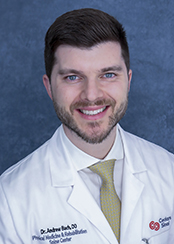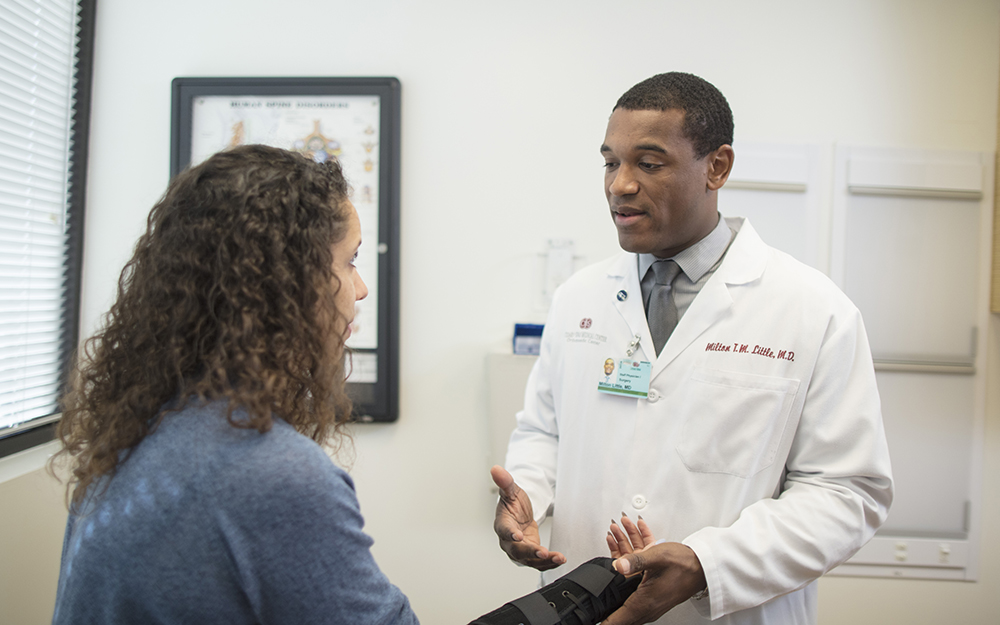Back Pain: Nonsurgical Treatments
Date
February 8, 2024

Date
February 8, 2024
Credits
Medical providers featured in this article

In Brief
{{cta-block}}
Some back pain can be helped with surgery, but it’s not usually necessary—and studies show that less invasive options work just as well.
About 99% of back and neck pain can be treated with effective, nonsurgical options that prioritize quality of life and cost efficiency, said Andrew Bach, DO, a physical medicine and rehabilitation specialist in the Nonoperative Spine Program at the Cedars-Sinai Spine Center.
Bach works with patients to identify the cause of their back pain, determine the safest solution and help them make treatment decisions.
“Just about everybody has back pain at some point in their lives,” he said. “It’s normal to have aches and pains if you’re active or you exercise. But if it lingers for more than a few weeks or affects your quality of life, a back and neck pain specialist can address it and focus on restoring function.”
{{providers}}
First, Get a Thorough Exam
Bach is a physiatrist, which is a type of doctor who specializes in evaluating and treating how the body functions as a whole. He prescribes pain management, behavioral health, massage and physical therapy instead of surgery or opioids. He also can refer patients to Cedars-Sinai’s Pain Center for injections to treat pain, when appropriate.
At an appointment to address a patient’s back or neck pain, Bach performs a thorough physical examination and asks questions about their history. It’s important to have an extensive conversation with your doctor, Bach says, to help determine all factors that might contribute to your pain.
“Talk to your doctor about your pain, but also tell them about your lifestyle, your work and your habits,” he said. “You never know what is relevant.”
Back surgery might be warranted when pain gets worse or continues to limit a patient’s functionality despite continued medical treatment. If back pain is accompanied by weight loss, fever, chills, night sweats, numbness, or tingling or weakness in the hands and feet, see a doctor immediately. Rarely, these symptoms can indicate a more systemic condition.
Personalized Care Plans
Some back pain is caused by arthritis, a pinched nerve or a bulging disc and can be directly diagnosed with imaging or electromyography studies. But about 90% of back pain is nonspecific, meaning doctors can’t identify an anatomical source of the pain.
In every case, there is a solution. Bach works with patients to determine the most effective course of treatment based on their personal motivations and pain severity.
Pain from pinched nerves usually subsides within two months or within one month with a short course of steroid medications. Bulging discs usually can be resolved with medications, application of heat and cold, massage, and acupuncture.
Most back pain is nonspecific and can be related to another part of the body. Tightness in the hips or hamstrings or weakness in the core or gluteal muscles can cause strain on the back. In such cases, Bach works with the patient to recommend medications, supplements or dietary changes, usually in conjunction with physical therapy.
The over-the-counter drugs acetaminophen (Tylenol) and ibuprofen (Advil) can be as effective at reducing pain as opioids, and they don’t come with side effects like drowsiness, sedation and risk of addiction, Bach says. Most people tolerate the drugs well, and they can be helpful until the pain goes away or is eliminated.
For patients who wish to avoid taking medications, Bach suggests evidence-based supplement solutions, like turmeric and pineapple, which have anti-inflammatory and wound-healing properties.
“It’s normal to have some aches and pains if you’re active or you exercise. But if it lingers for more than a few weeks or affects your quality of life, a back and neck pain specialist can address it and focus on restoring function."
Physical Therapy
When patients have acute pain, Bach often suggests they rest for up to several weeks before beginning physical therapy.
“Working through the pain isn’t always productive,” he said.
When it’s the right time, Bach makes seamless referrals for patients to be evaluated at Cedars-Sinai’s dedicated onsite center courtesy of Select Physical Therapy. Following the first visit, patients can choose to receive treatment at convenient Select Physical Therapy locations across the Los Angeles area.
Physical therapy can be uncomfortable when patients first begin care, but it is a more holistic and natural way to relieve and manage back pain. Once a treatment plan is developed with the physical therapist, which can include strengthening exercises, range of motion exercises and hands-on techniques, patients are often asked to complete a home exercise program to ensure they progress between center appointments. Bach stresses the tailored plans do work, as long as patients are staying the course.
“Sometimes, the solution seems pretty vague, like when we identify that a patient needs to work on their core strength,” Bach said. “But we tailor physical therapy prescriptions to each patient as much as we can.”
Physical therapy can be uncomfortable and often requires patients to complete certain exercises on their own as well as with therapists—but Bach stresses that the tailored plans do work, as long as patients follow the course.
“Patients do have to stay on top of things,” Bach said. “It’s hard to do, but it’s important.”
Getting Back to Normal—or Better
Whether your pain is recent or lifelong, Bach says it can and should be addressed in a holistic way. Pain reduction or elimination usually require patients to adhere to their providers’ guidance, which can sometimes mean patients have to make changes to their lifestyle. When the cause of the pain is a habit or activity that is otherwise important to a patient, Bach recommends alternatives.
For example, weightlifting can easily lead to injury, so Bach usually suggests patients instead focus on body weight exercises and calisthenics.
With communication, dedication to a tailored plan and patience, most back pain can be healed.
“There’s no magic solution or quick fix for neck or back pain, and patients will have good days and bad days,” Bach said. “Usually after six to eight weeks, people feel a lot better.”





